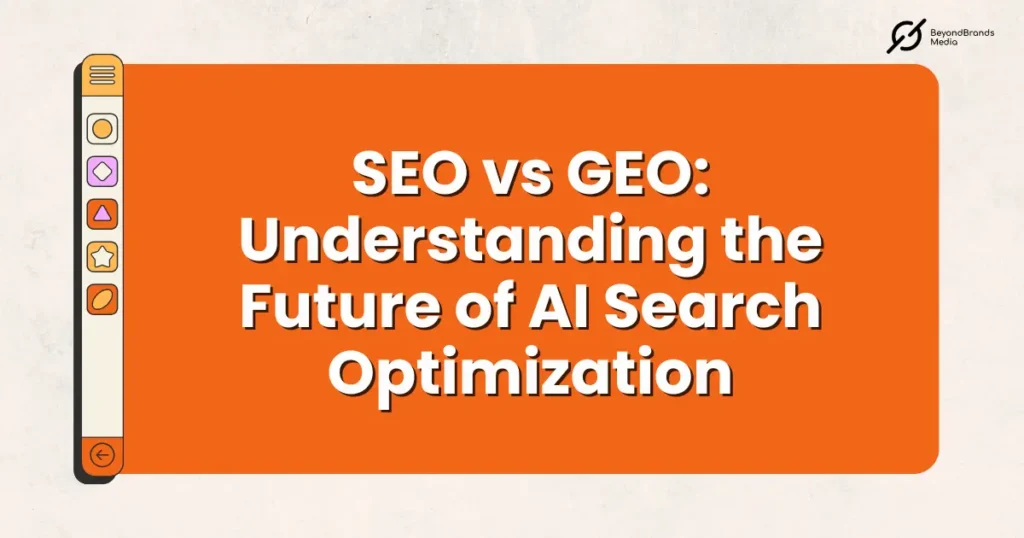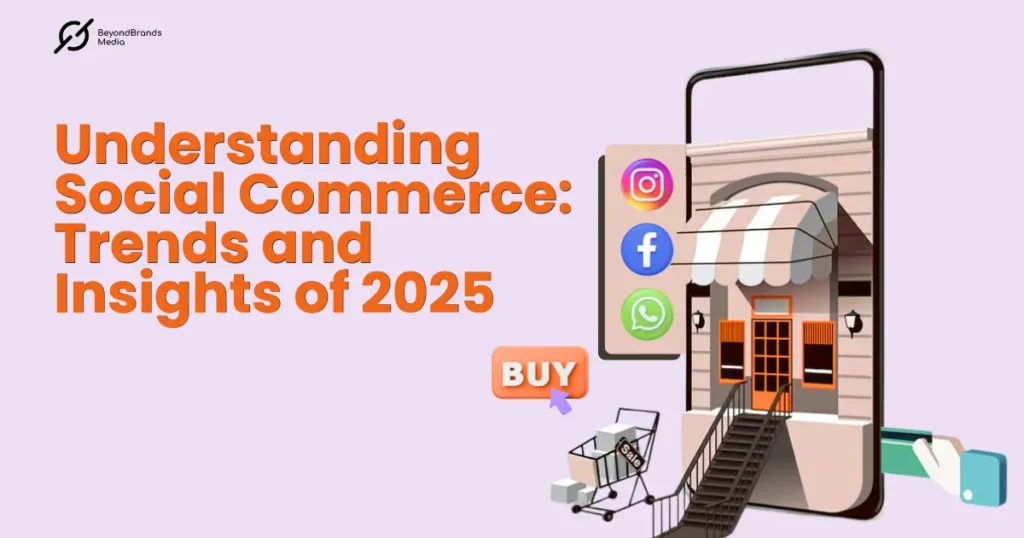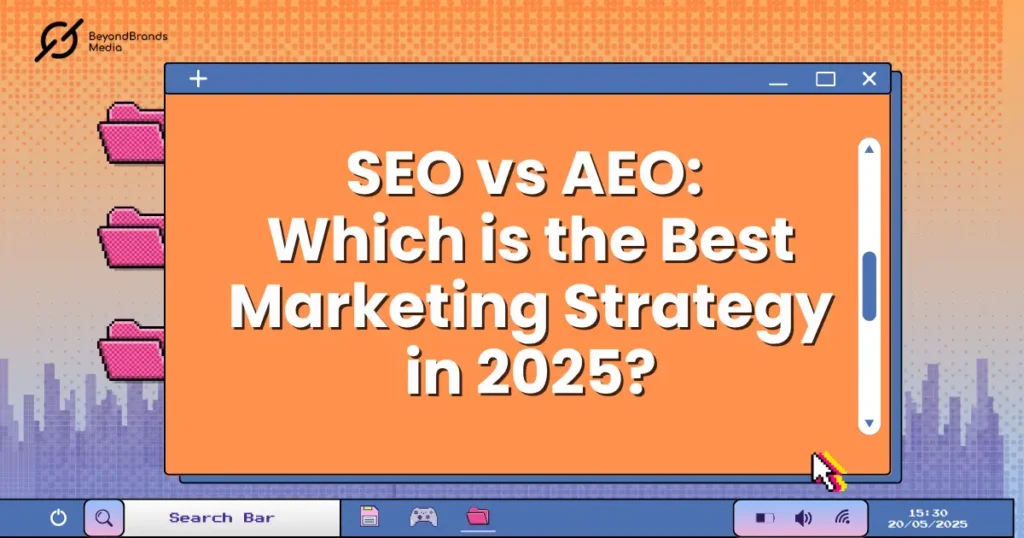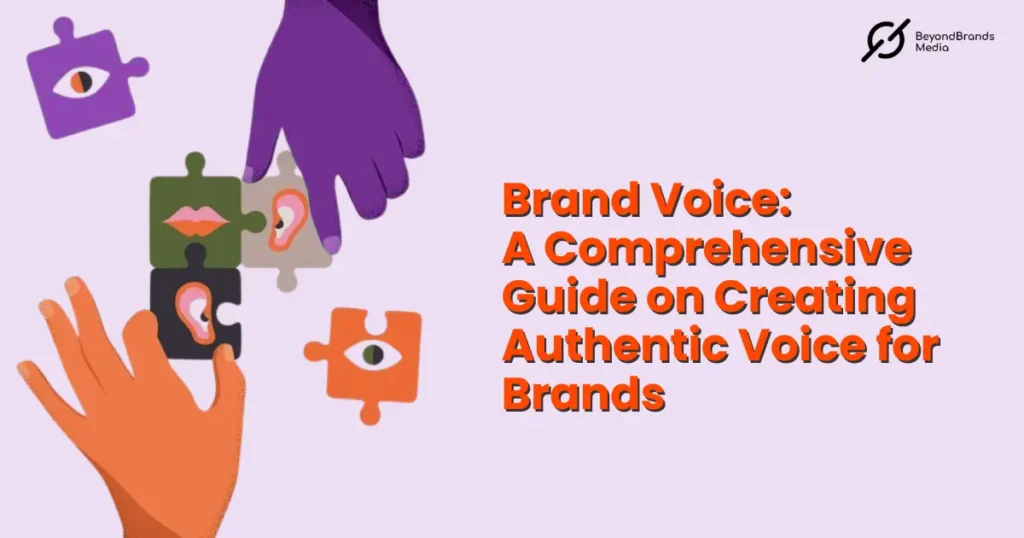SEO vs GEO: Understanding the Future of AI Search Optimization

With AI search becoming mainstream, the SEO vs GEO rift has surpassed more than being just a marketing buzzword. It’s all about the algorithmic shift in Google rankings in the past few years that led to the extended SEO family. As AI-powered search tools like ChatGPT, Google’s Search Generative Experience (SGE), and Perplexity grow are disrupting the search game, marketers and content creators are beginning to ask: Is GEO the future of SEO? How effectively and strategically are you implementing the new search rules to gain the competitive advantage? Let’s explore the key differences, how each works, and what the future holds for AI search optimization in this no-fluff guide. SEO vs AEO vs GEO: Understanding the Basics SEO (Search Engine Optimization): SEO, marketers’ most trusted organic search optimization tool to boost a brand’s visibility, driving organic traffic, improving rankings, and ensuring discoverability. Modern marketers still rely on SEO as the basic strategy to compete in saturated digital spaces. GEO ( Generative Engine Optimization): GEO, on the other hand, targets audiences based on location-specific data. It helps marketers deliver hyper-local content, personalized offers, and relevant campaigns, which is a part of local SEO, to increase engagement and conversions. In today’s mobile-driven world, GEO optimization is crucial for regional outreach and physical-to-digital customer mapping. AEO (Answer Engine Optimization): AEO is the evolved version of SEO that perfectly complements Google’s AI algorithmic shift, focusing on optimizing content to provide instant, comprehensive answers for voice search and AI-driven search engines. It’s vital today, as users increasingly rely on conversational queries, making it an essential modern marketing strategy. SEO vs GEO: Key Differences Feature SEO GEO Target Platform Search engines (Google, Bing) Generative AI tools (ChatGPT, SGE) Content Goal Ranking pages cited in AI-generated responses Optimization Method Keywords, links, metadata Natural language, structured data, and factual clarity Visibility Format Website links in search results AI-generated answers, snippets, citations Why Does GEO Matter in the Age of AI? AI chatbots and generative search platforms are reshaping how people find information. For example, when you voice search or even type search, “What’s the best camera for low-light photography?” Google SGE shows a ‘summarised version of the search result with cited sources’ Even AI like ChatGPT will summarize the answer in a similar pattern, citing sources. If your content is optimized for GEO, you increase your chances of being referenced in that answer. With AI search tools: ●Users skip the SERP and go directly to the answer. ●Citation-based traffic could replace click-through traffic. ●Topical authority matters more than keyword stuffing. In this paradigm, traditional SEO alone won’t suffice — GEO will be the game-changer Future of AI Search: Will GEO Replace SEO? Not exactly. GEO is not a replacement but a complement to SEO. Here’s why: ●SEO still drives traffic from classic searches, especially for e-commerce, service providers, and local businesses. ●GEO enhances visibility in AI-generated platforms where direct citations, summaries, or answer boxes appear. Together, SEO and GEO form a hybrid strategy that adapts to both humans and machines. As generative search engines like Google’s SGE evolve, content creators must integrate both SEO and GEO tactics to remain competitive. How to Prepare for GEO: Actionable Tips Remember, adapting to a new trend comes with its share of struggles and challenges, and so it’s important to partner with a reputed and modern-day digital marketing agency in Bangalore to gain an unbeatable competitive advantage. Here we share some tried and tested GEO winning tips to complement the algorithmic search. 1. Use Structured Data (Schema Markup) to help AI models understand your content format and metadata. 2. Answer Questions Clearly and Concisely by using FAQs, how-to guides, and definitions in your content. Think like an AI assistant. 3. Improve Topical Authority by creating clusters of related content around a central theme, so that AI tools recognize your site as an expert source. 4. Provide Accurate, well-cited information as AI engines prefer reliable content that includes external sources and studies. 5. Use conversational headings and subheadings that reflect how real users ask questions. Final Words: As AI transforms how users discover content, businesses must adapt strategies that blend traditional search practices with location intelligence. At Beyond Brands Media, we help you stay ahead of the curve by offering tailored solutions that combine both visibility and relevance. If you’re looking to amplify your reach and stay competitive in this AI-powered era, trust the best digital marketing agency in Bangalore to guide your journey. Let innovation lead your growth with Beyond Brands Media. SEO vs GEO FAQs Q1. Is GEO going to replace SEO entirely? No. SEO is still critical for traditional search engines. GEO is an extension that prepares your content for AI-based discovery. Q2. How can I check if my content appears in AI-generated answers? Currently, some platforms like Perplexity and Bing Chat show citations. You can also test queries in ChatGPT with browsing enabled and look for references. Q3. What industries benefit most from GEO? Industries with high informational queries, like tech, health, finance, and education, mainly benefited. Plus, local services and e-commerce can also leverage GEO to improve brand visibility in AI platforms. Q4. Are GEO strategies different from voice search optimization? They’re related. Both focus on natural language and intent-based queries. GEO goes further by optimizing for AI comprehension and citation.
Understanding Social Commerce: Trends and Insights of 2025

Being an active social media user, do you still think these platforms are limited in creating online connections among individuals? If yes, then it’s time to broaden your perception as social media has now turned into social commerce and culminating into activities like browsing and purchasing. This isn’t just e-commerce with a social media button; it’s a fundamental shift in consumer behavior and a dynamic new frontier for brands. 2025 hails a new era of social commerce for the users out there. As per the latest statistical record, in India, the average spending time on social commerce platforms is around 2.5 to 3 hours, which indicates a thriving condition of these applications. However, there are several reasons that are conducive to the surge in such activities that including UPI integration, mobile-friendly design, and a deep-seated trust in the recommendations of friends and closest ones. Curious to know what the key trends of social commerce platforms in 2025 are? Here in this blog of Beyondbrands Media, we will shed light on the valuable insights and trends regarding social apps. Key Trends Shaping Social Commerce in 2025 2025 has witnessed the dominance of millennials and Gen Zs, and the trend of social shopping is going on at a rapid pace. For instance, while scrolling Meta or Instagram, the vlogs of the famous influencers or the promotional posts mostly appeal to the young generation, and they encourage them to give those products a try for the best results. Let’s have a look at the pointers below to get a clear glimpse of the key trends that are shaping social e-commerce. 2025 has bid adieu to the separate website searching when platforms like Instagram and Meta are becoming the gateway to the direct shopping app. From the shoppable reels to product tags, these are ideated in such a way that increases the likelihood of conversion into sales. Nowadays, the customers crave the instant gratification of their demands, and these reels are fulfilling this need of the young generation shoppers. Social media for e-commerce in this way is leading towards a brighter future. In the Chinese market of China, live shopping is flourishing, and global consumers are gradually inclining towards this trend. Brands and influencers host real-time video events, showcasing products, answering questions, and offering limited-time deals. If you follow the digital marketing trends of this year, you will likely come across how augmented reality, or AR, is shaping the arena of shopping and bringing the products to life. Just imagine you are visiting a store and there you have no need to stand in a queue for a trial, but you can just go for a virtual “try on” to check whether the item suits you or not, and accordingly, can explore other available options. Isn’t it great? AR removes a major barrier in online shopping – the uncertainty of how a product will look in real life. This kind of immersive experience boosts the confidence of your targeted customer base and will make their shopping journey more fun and interactive at the same time. This year, the commercial activities are turning into social selling. Gone are those days when influencers were limited to just endorsing the branded items, as they are playing the role of direct sales channels. There are multiple platforms where social influencers have the freedom to integrate a storefront, and they can even earn commission from there. When it comes to authentic and trust-based conversion, the micro and nano influencers are always ahead. From Meta to Instagram, now you will find authentic reviews everywhere, and the high visibility decreases the chances of falsification. This way, real videos, testimonials, or reviews are highly influential in the purchasing decision of the customers. For better ROI, nowadays, the brands are including UGC in their monthly social media content calendar. Purchasing is no longer just picking a product and paying for it, as modern consumers are more prone to a clear conversation before investment. In India, WhatsApp Business is gaining popularity and offering features like product catalogue, direct purchase, and others. Conversational commerce offers a personalized, convenient, and often intimate shopping experience, mimicking real-world interactions. Future of Social Commerce After evaluation of the trends and insights, you can clearly assume that social commerce in India and outside is going to thrive in the upcoming years and will become the only reality. It also marks a fundamental shift from offline buying to online direct buying. It’s about building immersive, engaging, and highly personalized shopping experiences within the communities where people already connect. Brands that understand and embrace this evolution will not only thrive but will redefine the very essence of online retail in the years to come. Case Study The rise of Meesho in India is a great example of the wonder of social commerce that began its journey as Vidit Aatrey and Sanjeev Barnwal. It integrated its social commerce model with e-commerce to empower the local microentrepreneurs and even helped the homemakers, freshers, and others to act as resellers and to earn money. Besides that, Meesho has introduced features like a zero-commission model, tech integration, direct sales, and others to make a prominent position in the Indian commercial scenario. Social Commerce FAQs Q1. What is an example of social e-commerce? Social commerce is all about selling products by integrating with social media platforms like Meta, Instagram, and so on. Korean beauty brand JOAH Beauty is an excellent example of social e-commerce that uses TikTok to leverage both organic and paid content. Q2. What is the difference between social commerce and e-commerce? Both of these terms represent two distinct approaches to online selling. It broad practice of buying and selling goods and services over the internet and focuses on product listing, descriptions, and others. It stands for direct selling of the products through social media channels and facilitates the overall process from discovery to purchase, without the user ever leaving the social app. Q3. Which social media platforms work best for social commerce, and
SEO vs AEO: Which is the Best Marketing Strategy in 2025?

Keeping up with the ever-evolving digital marketing trends is the key to keeping your marketing game on point. The latest tussle between SEO vs AEO is keeping modern marketers on hook to determine the ultimate strategy complementing their marketing goals. While SEO is still marketers’ reliable route to uncompromised search supremacy, AEO is emerging as the latest catalyst to probably disrupt the search domain forever. As digital marketing trends shift towards AI-driven search experiences, integrating both SEO and AEO strategies becomes essential. Let’s unleash the two big factors in digital marketing in this informative guide. Understanding SEO and AEO To begin with, let’s specify SEO and AEO in the simplest definitions Search Engine Optimization (SEO) SEO is all about optimizing your website’s core vitals to gain a higher rank in search engine results pages (SERPs). It focuses on factors like keyword usage, backlink building, and website performance to drive organic traffic. A traditional SEO blueprint is crafted to improve your website’s organic credibility across search engines like Google and Bing. Answer Engine Optimization (AEO) AEO is the new kid on the block that emerged since the advent of Google’s Generative Search. AEO can be considered the evolving form of SEO that targets AI-powered search tools and voice assistants. AEO provides crisp, direct answers to your queries through structured data and FAQs. AEO aims to respond to users seeking immediate information, reducing the effort of navigating through multiple web pages. Key Differences between SEO and AEO Here we present a comparative guide of the key aspects between SEO and AEO to offer you a clearer insight. Parameters SEO AEO Objective Improve organic visibility in traditional search engine results. Provides direct answers to AI-powered search tools and voice assistants Content Focus In-depth articles and blog posts focused on specific keywords Precise answers through snippets, FAQs, and structured data Users’ Engagement Through in-depth research across multiple web pages Instant answer without a hectic search Optimization Tools Keyword research, backlinking, and on-page SEO techniques. Schema markup, structured data, and conversational content. Search Platforms Traditional search across Google and Bing. AI platforms, voice assistants, and chatbots The Importance of Integrating SEO and AEO Combining SEO and AEO strategies has become imperative with the evolving searchers’ behavior to ensure comprehensive digital visibility. The strategic fusion can significantly boost the following key digital marketing parameters: Enhanced User Experience: Providing both detailed content and quick answers caters to diverse user preferences, offering searchers a fast and engaging experience. Increased Reach: Optimizing content for both organic and AI-driven search platforms is a proven strategy to boost audience engagement. This will keep audiences hooked to your content and increase repeat website visits and engagement. Future-Proofing: Staying ahead of digital marketing trends is essential to staying competitive. The only practical way to dominate the present and future marketing landscape is to apply the best of evolving marketing strategies and keep a pulse on evolving search behaviors. Key Step to Follow Before Integrating SEO and AEO When updating or redesigning websites in sync with the latest trends, there are certain key factors to consider, such as: Comprehensive Audit: Analyze the performance of your current website using tools to identify areas for improvement and applicable strategies. Redirect Mapping: Implement 301 redirects to preserve link equity and guide users to new URLs. Content Optimization: This is one essential step to align with current SEO and AEO best practices. Update your content according to searchers’ preferences and AI-powered searches. Performance Monitoring: Keep a tab on your website metrics post-migration to address any issues promptly. Lagging here means an opportunity missed. Future Trends in Digital Marketing As technology services in Bangalore continue to advance, digital marketing is rapidly evolving. In fact, the trends shaping this year are set to define the marketing landscape well into next year, with AI and voice search emerging as powerful driving forces behind this transformation. AI Integration: Modern marketers will use AI to craft hyper-personalized content and predictive analytics. Voice Search Optimization: Adapting content for voice-activated searches and smart devices will be the prime focus for optimum engagement and conversions. Interactive Content: Engaging users through quizzes, polls, interactive videos, and social media posts will drive desired results. Data Privacy Compliance: Ensuring marketing strategies align with data protection regulations will be imperative for companies to maintain transparency in the user-brand equation. Are you seeking direction in the ocean of evolving marketing strategies? Not sure about how to implement the best of SEO and AEO for your brand’s voice? Knock Us! Conclusion: Understanding the distinctions between SEO and AEO is essential for any business today, aiming to boost its online presence. By integrating both strategies, companies can cater to evolving user behaviors and technological advancements, ensuring sustained digital success. Partnering with the Best Digital Marketing Agency in Bangalore can guide you with tailored strategies encompassing SEO, AEO, and beyond. Agencies like BeyondBrands Media specialize in delivering comprehensive digital marketing services, ensuring your vision and business stay aligned in the competitive digital landscape. SEO vs AEO FAQs Q1. What is the difference between AEO and SEO? SEO focuses on optimizing content to rank higher in traditional search engine results (like Google), while AEO is about optimizing content to provide instant answers for answer engines (like voice assistants or featured snippets). SEO drives clicks, and AEO aims to satisfy queries instantly. Q2. Why is AEO becoming more important than traditional SEO? With the rise of voice search and AI-powered assistants, users increasingly expect quick, spoken answers instead of browsing through links. AEO addresses this shift by delivering quick, structured answers, making it crucial for future-ready digital strategies. Q3. Can AEO and SEO work together? Absolutely. AEO is not a replacement for SEO but an extension of it. Optimizing for both ensures your content ranks well in traditional searches and gets featured in answer boxes, voice responses, and AI-generated results. Q4. How do I optimize my content for AEO? To optimize for AEO, focus on: Answering specific questions clearly and concisely Using structured data
Brand Voice: A Comprehensive Guide on Creating Authentic Voice for Brands

Whenever you are visiting a local market, have you ever heard the loud “street cries” of the vendors? Of course, almost all of us have witnessed such unique ways of the vendors for merchandising their product offerings. When it shifts to the digital sphere, the scenario also remains the same, as here the brands are identified by the distinct voices they have possessed. Not all brands are created equal, and due to that, the brand voice of each should be unique. In today’s hyper-connected, content-saturated world, where consumers are bombarded with messages from every direction, just existing is no longer sufficient. Standing out, building trust, and fostering genuine connection demands more than a mere product or service. Brand tone of voice in reality refers to an exclusive linguistic and emotional style that the brand utilises across all its existing channels of communication. Now, it has become a fundamental necessity to craft a unique brand voice that can create noise in the crowded marketplace. Here in this blog of BeyondBrands Media, a branding agency in Bangalore, we are going to encompass the nitty-gritty aspects associated with brand voice and expert tips for creating it for the multiple brands out there. What is a Brand Voice? In reality, brand voice is the personality and emotion associated with a business, which are expressed via the different channels of communication. It says a lot about your brand and weaves a wonderful story to set your brand apart from the others in the marketplace. When we stress upon the visual branding activities like logo creation, the choice of fonts, and others, brand voice takes into account everything from language to personality to leave behind an unforgettable effect. Although the voice of the brand is something abstract, it is conducive to creating a buzz in the marketplace. For instance, whenever we read or encounter Nike’s famous “ just do it” slogan, we can instantly feel the inspirational aspects associated with this eminent brand. Let’s move to the next section to find out why having a voice is extremely crucial for a brand. Why is Brand Voice Crucial? When there are multiple brands in a competitive marketplace, it becomes a daunting task for your brand to get noticed. A voice or tone of a brand works like a unique fingerprint that any other brand can hardly replicate. Here are the reasons that mandate the brands to possess their unique voice. Building Trust: Having a consistent voice offers a competitive edge to brands to win the trust of consumers out there. For instance, Apple, as a high-end brand, has set its brand tone in a way that appeals to the premium customer base. This is a strategic move adopted by Apple to cater to the specific demands of the targeted customer base. Plus, the luxury segment of consumers tends to rely on this brand as its tone of voice resonates with the demands of the targeted group of audience. Creating an Emotional Connection: Voice allows your brand to convey emotion, values, and a sense of shared understanding, forging deeper bonds with your audience. Attracting the Right Audience Base: For the brands out there, attracting the right set of audience is necessary. Here, the unique brand voice naturally attracts people, leading to a more engaged and loyal customer base. Elements to Consider While Crafting Brand Voice If you are willing to create your personal brand or work on an existing brand, infusing it with an authentic voice is of paramount importance. However, developing an effective voice or brand tonality requires clear thoughts and strategic planning. Here are some of the key elements that you must consider while crafting the voice. Personality: Brand personality is something that must shine through in every word chosen by you. Always consider your brand as a person and then decide whether it’s a sophisticated expert, quirky friend, or something else. It will help you endow your brand with a specific personality that leaves a mark behind. Tone: The tone of a brand says a lot about its values, and it stands for the emotional qualities that resonate with the demands of the consumers. For instance, if your brand has an optimistic tone, it can still adopt a sympathetic tone at a time whenever addressing the customer complaint. Language: Your choice of words is another crucial tenet as it determines how your brand will create an impression in the mind of the audience. To create a positive brand perception, you must choose the words that align with your business values and mission. Audience: Understanding your target demographic’s language, values, and communication preferences is paramount to crafting a voice that truly connects. Purpose: Last on the list, consider the purpose of the brand, which will aid you in subtly shaping the voice. Tips for creating an authentic brand voice for your business The digital landscape is rapidly evolving, but that doesn’t mean that you can change your brand voice every time. For this reason, the choice of brand tone must be strategic so that you do not need to change it to adjust to the market trends. Have no idea about how to craft a voice that lasts longer in the mind of the audience? Here we are presenting some of the expert tips to help you out. Embracing AI: Content plays a crucial role in building a brand voice. It is recommended to trust in advanced AI tools for content creation, but include human inputs every time to make the voice more compelling, authentic, and culturally nuanced. Prioritising Empathy: In this current era, having a voice that listens, understands, and responds with genuine care is absolutely mandatory for cutting through the noise outside. So, choose the words that reflect a sense of empathy. Focus on Storytelling: Having a brand’s story is important, and here you must use your voice to narrate compelling stories. Instead of relying on the facts only, begin to evoke emotion through the story of your brand. Closing Thoughts: The voice
